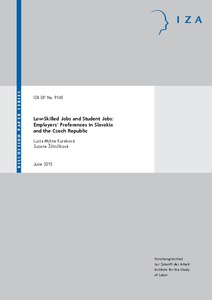Low-skilled jobs and student jobs: employers' preferences in Slovakia and the Czech Republic
"Massification of tertiary education, growing share of student workers on labour market and consequently increased competition for low-skilled jobs gave rise to the theory of crowding out of the less educated workers. This paper contributes to better understanding of temporary skills-qualificat...
| Main Authors: | , |
|---|---|
| Institution: | ETUI-European Trade Union Institute |
| Format: | TEXT |
| Language: | English |
| Published: |
Bonn
2015
IZA |
| Subjects: | |
| Online Access: | https://www.labourline.org/KENTIKA-19111552124919397349-Low-skilled-jobs-and-student-j.htm |
| Summary: | "Massification of tertiary education, growing share of student workers on labour market and consequently increased competition for low-skilled jobs gave rise to the theory of crowding out of the less educated workers. This paper contributes to better understanding of temporary skills-qualifications mismatch typical for student workers by analysing the preferences of employers in low-skilled jobs and student jobs. We take labour market demand perspective and carry out exploratory analysis of job offers posted online in Slovakia and the Czech Republic. The results show that the student labour market is quite diverse as student job offers can be found in low-skilled, but also medium-skilled positions. We also find that although student vacancies require, on average, fewer skills than non-student positions, there is strong correlation between formal sophistication of a job vacancy and the required minimum educational level, as well as required skills for both student and non-student positions. It appears that low-educated workers and student workers do not compete for the limited number of positions, but rather fill employers' demands for different types of hard (e.g. language skills) and soft (e.g. flexibility, adaptability) skills. These results support the complementarity view of the coexistence of student employment and low-skilled employment rather than the crowding out theory." |
|---|---|
| Physical Description: | 39 p. Digital |

